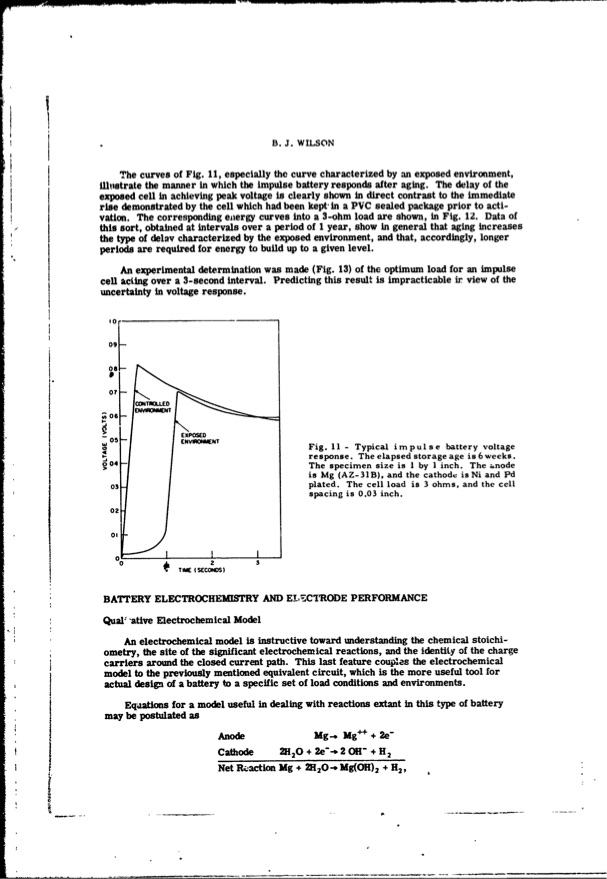
PDF Publication Title:
Text from PDF Page: 013
I *S B. J. WILSON 'The curves of Fig. 11, especially the curve characterized by an exposed environment, illustrate the manner in which the impulse battery responds after aging. The delay of the exposed ceil in achieving peak voltage is clearly shown in direct contrast to the immediate rise demonstrated by the cell which had been kept-in a PVC sealed package prior to acti- vation. The corresponding energy curves into a 3-ohm load are shown, in Fig. 12. Data of this sort, obtained at intervals over a period of 1 year, show in general that aging increases the type of delay characterized by the exposed environment, and that, accordingly, longer periods are required for energy to build up to a given level. An experimental determination was made (Fig. 13) of the optimum load for an impulse cell acting over a 3-second interval. Predicting this result is impracticable ir view of the uncertainty in voltage response. 10 09 05 4EVWAmNNT Fig. 11 - Typical impulse battery voltage response. The elapsed storage age is 6 weeks. specimen size is I by I inch. The a~node is Mg (AZ-31B), and the cathodc is Ni and Pd plated. The cell load is 3 ohms, and the cell spacing is 0.03 inch. 03 DO 023 004-The 02 TIME(SECONDS ) BATTERY ELECTROCHEMISTRY AND ELECTRODE PERFORMANCE Qual -afive Electrochemical Model An electrochemical model is instructive toward understanding the chemical stoichi- ometry, the site of the significant electrochemical reactions, and the identity of the charge carriers around the closed current path. This last feature coupaes the electrochemical model to the previously mentioned equivalent circuit, which is the more useful tool for actual design of a battery to a specific set of load conditions and environments. Eq~ations for a model useful in dealing with reactions extant in this type of battery may be postulated as Anode Mg-- Mg++ + 2e- Cathode 2H20 + 2e-w 2 OH" + H2 NetlWaction Mg+2H20-*Mg(OH)2 +H2, SiPDF Image | INERT-CATHODE SEA-WATER BATTERY

PDF Search Title:
INERT-CATHODE SEA-WATER BATTERYOriginal File Name Searched:
AD0673399.pdfDIY PDF Search: Google It | Yahoo | Bing
Product and Development Focus for Salgenx
Redox Flow Battery Technology: With the advent of the new USA tax credits for producing and selling batteries ($35/kW) we are focussing on a simple flow battery using shipping containers as the modular electrolyte storage units with tax credits up to $140,000 per system. Our main focus is on the salt battery. This battery can be used for both thermal and electrical storage applications. We call it the Cogeneration Battery or Cogen Battery. One project is converting salt (brine) based water conditioners to simultaneously produce power. In addition, there are many opportunities to extract Lithium from brine (salt lakes, groundwater, and producer water).Salt water or brine are huge sources for lithium. Most of the worlds lithium is acquired from a brine source. It's even in seawater in a low concentration. Brine is also a byproduct of huge powerplants, which can now use that as an electrolyte and a huge flow battery (which allows storage at the source).We welcome any business and equipment inquiries, as well as licensing our flow battery manufacturing.| CONTACT TEL: 608-238-6001 Email: greg@salgenx.com | RSS | AMP |